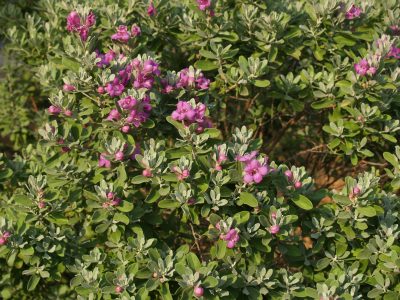Cenizo (Texas Sage)
Leucophyllum frutescens

Texas sage is also known as Texas sage, purple sage, Texas ranger, and many other common names.
Cenizo is extremely drought tough and needs very little water once established. In fact, this shrub does not like ‘wet feet,’ so be very careful if planting in clay soils.
Cenizos require full sun to bloom and be healthy, and really don’t tolerate shady areas.
There are a multitude of different varieties of cenizo to choose from, differing not only in leaf and flower color, but also in height and width. So when choosing this plant, be careful to get a variety that has the characteristics that you want, especially when it comes to size.
Cenizo does not respond well to heavy pruning, so if it outgrows its space in your landscape, you won’t be able to prune it back and keep it smaller. Overly-pruned cenizos will show lots of die-back, especially in the center of the plant, with only a little growth at the tips. Unfortunately, this shrub is often planted in rows and sheared back to make a hedge. This is not a good practice, and will cause the shrubs to look very ugly, twiggy, and almost dead. Which they will be, since most of the living tissue will have been removed.
The most common cenizos have gray-green leaves with light lavender flowers. But you may also found varieties with a greener leaf and deeper lavender blooms. More rarely, you may even find some with white blooms. Some will also have more and larger flowers than others, giving you a wide palette to choose from.
I have seen Texas sages abandoned by the side of the freeway in El Paso, happily blooming their heads off in the full heat of summer, after the rainy season has arrived. These west Texas natives are also known as barometer bush, because they bloom in response to heat and relative humidity, leading some to say that they are good predictors of rain.
categories:
tags:
